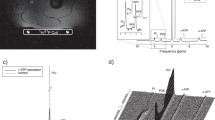Abstract
Cellular pH control is important in muscle physiology, and for interpretation of 31P magnetic resonance spectroscopy (MRS) data. Cellular acidification in exercise results from coupled glycolytic ATP production mitigated by cytosolic buffering, ‘consumption’ of H+ by phosphocreatine (PCr) breakdown, and membrane transport processes. Ex vivo methods for cytosolic buffer capacity are vulnerable to artefact, and MRS methods often require assumptions. 31P MRS of early exercise, when pH increases unopposed by glycolysis, is conceptually simple, but limited in normal muscle by time resolution and signal-to-noise. A therapeutic trial (Martinuzzi A et al. Musc Nerve 37: 350–357, 2007) in McArdle’s disease (glycogen phosphorylase deficiency), where pH does not decrease with exercise, offered the opportunity to test 31P MRS data obtained throughout incremental plantar flexion exercise and recovery in ten McArdle’s patients against the simple model of cellular pH control. Changes in pH, [Pi] and [PCr] throughout exercise and recovery were quantitatively consistent with mean ± SEM buffer capacity of 10 ± 1 mM/(pH unit), which was not significantly different from the control subjects under the initial-exercise conditions where the comparison could be made. The simple model of cellular acid–base balance therefore gives an adequate account of cellular pH changes during both exercise and recovery in McArdle’s disease.



Similar content being viewed by others
References
Adams GR, Foley JM, Meyer RA (1990) Muscle buffer capacity estimated from pH changes during rest-to-work transitions. J Appl Physiol 69:968–972
Arnold DL, Matthews PM, Radda GK (1984) Metabolic recovery after exercise and the assessment of mitochondrial function in vivo in human skeletal muscle by means of P-31 NMR. Magn Reson Med 1:307–315. doi:10.1002/mrm.1910010303
Bendahan D, Kemp GJ, Roussel M, Fur YL, Cozzone PJ (2003) ATP synthesis and proton handling in muscle during short periods of exercise and subsequent recovery. J Appl Physiol 94:2391–2397
Haller RG, Vissing J (2002) Spontaneous “second wind” and glucose-induced second “second wind” in McArdle disease: oxidative mechanisms. Arch Neurol 59:1395–1402. doi:10.1001/archneur.59.9.1395
Juel C (2008) Regulation of pH in human skeletal muscle: adaptations to physical activity. Acta Physiol (Oxf) 193:17–24. doi:10.1111/j.1748-1716.2008.01840.x
Kemp G (2005) Lactate accumulation, proton buffering, and pH change in ischemically exercising muscle. Am J Physiol 289:R895–R901
Kemp GJ, Taylor DJ, Radda GK (1993a) Control of phosphocreatine resynthesis during recovery from exercise in human skeletal muscle. NMR Biomed 6:66–72. doi:10.1002/nbm.1940060111
Kemp GJ, Taylor DJ, Styles P, Radda GK (1993b) The production, buffering and efflux of protons in human skeletal muscle during exercise and recovery. NMR Biomed 6:73–83. doi:10.1002/nbm.1940060112
Kemp GJ, Taylor DJ, Thompson CH, Hands LJ, Rajagopalan B, Styles P, Radda GK (1993c) Quantitative analysis by 31P magnetic resonance spectroscopy of abnormal mitochondrial oxidation in skeletal muscle during recovery from exercise. NMR Biomed 6:302–310. doi:10.1002/nbm.1940060504
Kemp GJ, Thompson CH, Sanderson AL, Radda GK (1994) pH control in rat skeletal muscle during exercise, recovery from exercise, and acute respiratory acidosis. Magn Reson Med 31:103–109. doi:10.1002/mrm.1910310203
Kemp GJ, Roberts N, Bimson WE, Bakran A, Harris PL, Gilling-Smith GL, Brennan J, Rankin A, Frostick SP (2001a) Mitochondrial function and oxygen supply in normal and in chronically ischemic muscle: a combined 31P magnetic resonance spectroscopy and near infrared spectroscopy study in vivo. J Vasc Surg 34:1103–1110. doi:10.1067/mva.2001.117152
Kemp GJ, Roussel M, Bendahan D, Le Fur Y, Cozzone PJ (2001b) Interrelations of ATP synthesis and proton handling in ischaemically exercising human forearm muscle studied by 31P magnetic resonance spectroscopy. J Physiol 535:901–928. doi:10.1111/j.1469-7793.2001.00901.x
Kemp GJ, Boning D, Beneke R, Maassen N (2006) Explaining pH change in exercising muscle: lactic acid, proton consumption, and buffering vs strong ion difference. Am J Physiol 291:R235–R237
Kemp GJ, Meyerspeer M, Moser E (2007) Absolute quantification of phosphorus metabolite concentrations in human muscle in vivo by 31P MRS: a quantitative review. NMR Biomed 20:555–565. doi:10.1002/nbm.1192
Kushmerick MJ (1997) Multiple equilibria of cations with metabolites in muscle bioenergetics. Am J Physiol 272:C1739–C1747
Leem CH, Vaughan-Jones RD (1998) Sarcolemmal mechanisms for pHi recovery from alkalosis in the guinea-pig ventricular myocyte. J Physiol 509:487–496. doi:10.1111/j.1469-7793.1998.487bn.x
Lindinger MI, Kowalchuk JM, Heigenhauser GJ (2005) Applying physicochemical principles to skeletal muscle acid-base status. Am J Physiol 289:R891–R894. doi:10.1152/ajpcell.00080.2005
Martinuzzi A, Liava A, Trevisi E, Frare M, Tonon C, Malucelli E, Manners D, Kemp GJ, Testa C, Barbiroli B, Lodi R (2007) Randomized, placebo-controlled, double-blind pilot trial of ramipril in McArdle’s disease. Muscle Nerve 37:350–357. doi:10.1002/mus.20937
McCully KK, Fielding RA, Evans WJ, Leigh JSJ, Posner JD (1993) Relationships between in vivo and in vitro measurements of metabolism in young and old human calf muscles. J Appl Physiol 75:813–819
Meyerspeer M, Kemp GJ, Mlynarik V, Krssak M, Szendroedi J, Nowotny P, Roden M, Moser E (2007) Direct noninvasive quantification of lactate and high energy phosphates simultaneously in exercising human skeletal muscle by localized magnetic resonance spectroscopy. Magn Reson Med 57:654–660. doi:10.1002/mrm.21188
Paganini AT, Foley JM, Meyer RA (1997) Linear dependence of muscle phosphocreatine kinetics on oxidative capacity. Am J Physiol 272:C501–C510
Robergs RA, Ghiasvand F, Parker D (2004) Biochemistry of exercise-induced metabolic acidosis. Am J Physiol 287:R502–R516
Swietach P, Spitzer KW, Vaughan-Jones RD (2007) pH-Dependence of extrinsic and intrinsic H+-ion mobility in the rat ventricular myocyte, investigated using flash photolysis of a caged-H+ compound. Biophys J 92:641–653. doi:10.1529/biophysj.106.096560
Trenell MI, Sue CM, Kemp GJ, Sachinwalla T, Thompson CH (2006) Aerobic exercise and muscle metabolism in patients with mitochondrial myopathy. Muscle Nerve 33:524–531. doi:10.1002/mus.20484
Acknowledgments
The financial support of Telethon Italy (Grant GUP03501 to A.M. and R.L.) is acknowledged. We thank all patients and control subjects for their cooperation.
Author information
Authors and Affiliations
Corresponding author
Rights and permissions
About this article
Cite this article
Kemp, G.J., Tonon, C., Malucelli, E. et al. Cytosolic pH buffering during exercise and recovery in skeletal muscle of patients with McArdle’s disease. Eur J Appl Physiol 105, 687–694 (2009). https://doi.org/10.1007/s00421-008-0950-0
Accepted:
Published:
Issue Date:
DOI: https://doi.org/10.1007/s00421-008-0950-0




